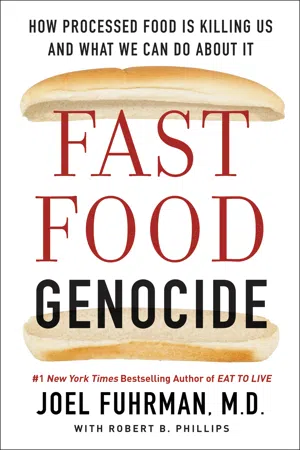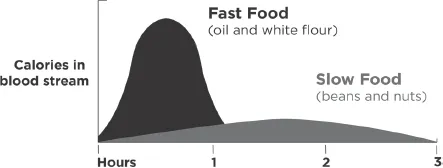![]()
CHAPTER ONE
FAST FOOD AND DISEASE
Of all the preposterous assumptions of humanity over humanity, nothing exceeds most of the criticisms made on the habits of the poor by the well-housed, well-warmed, and well-fed.
—HERMAN MELVILLE
Let’s start with the basics: “Fast food” is, literally, fast food. That means you can get it fast, eat it fast, digest it fast, and assimilate it into your fat cells fast—all with minimal effort.
Addiction to fast food is likely the most far-reaching and destructive influence on our population today. As I show in the following pages, this addiction has had an increasingly and dramatically negative effect on our society. Certainly, given what we know about the health effects of cigarettes, you have to be insane to smoke, but in this book I explain why the health effects of regularly consuming fast food may be even more severe than smoking.
I define fast food in two ways: First, it is the food served at commercial chain restaurants, where processed meats, pizza, burgers, French fries, pretzels, soft drinks, and rich desserts are made in an assembly-line process, with commercial ingredients that are duplicated and dispersed all over the world. Second, it is any commercially made food that includes artificial ingredients, processed grains, sweeteners, salt, and oil, with minimal nutrient content.
Most of us are aware that many chain restaurants aren’t serving up healthy foods, but the second definition of fast food is often confusing to many and just as lethal. These “fake” foods—the frozen waffle, the deli sandwich, the frozen pizza, the bag of chips, and much more—are easily available at our local supermarkets and convenience stores. Processing foods removes and destroys the fragile micronutrients and phytochemicals we need for cellular normalcy, and also adds toxins.
Toxins added to fast foods and processed foods include artificial colors, artificial flavors, preservatives, pesticides, antifoaming agents, emulsifiers, stabilizers, and thickeners. These ingredients give foods the texture and consistency that consumers expect. Added toxins also include cleaning chemicals, whitening chemicals, and packagsing components. Fast foods are toxic; they accelerate death through these added toxins but also by supplying concentrated calories without substantial fiber or the micronutrients humans need to sustain a normal life.
This book is not an exposé about fast food restaurants. Fast food includes all types of junk food too, regardless of where it is purchased. These human-created fakes are not only served at fast food restaurants, but in almost every food store across the country. After all, fast food restaurants could decide now, or in the future, to serve healthy (or healthier) foods. Instead, this book is a condemnation of the fast food style of eating—the consumption of mass-processed convenience foods in general. These foods include commercial and preserved (deli) meats and cheeses, cold breakfast cereals, sandwiches that use bread and rolls made from white flour, burgers, pizza, soft drinks, ice cream, doughnuts, cookies, marshmallows, and candies. These, and other “recreational” foods, have drug-like effects that are damaging the emotional fabric of our country and creating an immense and growing burden of human health tragedies. When I use the terms “fast food” or “junk food” throughout this book, I refer to this broad definition—not merely the foods served at quick-serve, take-out restaurants.
FAST FOOD IS SUICIDE ON THE INSTALLMENT PLAN
Obesity affects approximately 35 percent of Americans. This means that a staggering 100 million people are obese in the United States, and 100 million more are significantly and dangerously overweight, but not yet obese.1 This is not just a cosmetic issue; fat on the body is indicative of heart disease, diabetes, and cancer lurking within, if not now, then in a few years. Fast food causes disease: The more you eat of it, the fatter and sicker you become, and the faster you age. Eating fast food kills more people prematurely than smoking cigarettes.2
Gallup polls have shown that today in the United States, 19 percent of adults smoke, which pales in comparison with the 45 percent of adults who smoked in the 1950s.3 Compare this 19 percent of Americans who smoke to the proportion of Americans who eat fast food: 16 percent eat fast food several times a week; 28 percent eat fast food about once a week; and 80 percent eat fast food at least once a month. Only 4 percent say they never eat fast food.4 But this is only the tip of the iceberg because they are using the narrow definition of “fast food,” considering only food purchased in fast food restaurants when over half the American diet is nutrient-barren processed foods not purchased at fast food establishments.
A person who eats fried foods, fast food, and processed foods has at least ten times the heart attack risk of someone who eats reasonably healthy food.5 This link between unhealthy foods and heart disease was confirmed in the Harvard Health Professionals Follow-up Study, which showed that if we follow men over time, those making healthier lifestyle choices are associated with a 90 percent drop in heart disease risk, while women making healthier lifestyle choices had a 92 percent drop.6 This huge drop in heart attacks underestimates the benefits of healthy eating, because although the diets evaluated were better than average, they were far from ideal. Based on epidemiologic studies, survey studies, and clinical evidence, a person following a Nutritarian diet style (which I will describe in detail in Chapter 3 and Chapter 7) has at least a hundredfold less risk of developing heart disease than one eating the SAD.
Heart disease is the leading cause of death in the United States.7 Researchers at the University of Minnesota School of Public Health evaluated the frequency of more than fifty thousand individuals eating Western-style fast food and their risk of dying of heart disease. They found the following:
• Eating fast food two to three times per week increased the risk of dying from coronary artery disease more than 50 percent.
• The greatest risk was found when subjects ate fast food four or more times weekly; the risk of dying from coronary artery disease rose to 80 percent under those conditions.
• Even eating fast food just once a week increased heart disease risk by 20 percent.8
These heart disease deaths, and the risks reported, were also greatly underestimated, as the participants were followed for only about fifteen years. Plus, all the unhealthy, processed food eaten outside of fast food restaurant settings were not included in the analysis. The participants were not eating anything resembling an ideal cardioprotective diet, which could have offered dramatic protection against heart disease.
FAST FOOD HAS SIX CHARACTERISTICS:
• It is digested and absorbed rapidly.
• It contains multiple synthetic ingredients.
• It is calorically dense.
• It is nutritionally barren.
• It is highly flavored.
• It contains excess salt and sugar.
The faster the calories of a food enter the bloodstream, the higher the release of fat storage hormones and the greater the increase in dopamine (a driver of addiction in the brain). Because of these hormonal effects, fast foods initiate and perpetuate food addiction and cravings. The chief fat storage hormone is insulin, and the excessive insulin response to fast food leads to the promotion of fat storage, weight gain, cellular replication, and eventually cancer.
Speed of Absorption of Calories in Fast Food Versus Slow Food
The glycemic index, or glycemic load, considers the rate at which glucose builds up in the bloodstream over time. The more rapid and concentrated the elevation of glucose in the blood, the more significant the risk of life-threatening disease developing. The more quickly the brain can sense that rush of sugar into the bloodstream, the more its pleasure center gets stimulated and trained to direct more sugar-seeking behavior. Eating sweets and high-glycemic carbohydrates enhances the desire and craving for these foods. This influences decision-making and makes stimulating, addictive behaviors desirable. Despite the known dangers of these foods, the American public has demonstrated that they will fight to maintain their favorite addictive substances—sugar and white flour—and ignore the undeniable amount of accumulated evidence revealing the dangers of these substances.
In contrast, the more subtle levels of sugar in natural foods, in conjunction with the fiber and phytochemicals that slow the entry of sugar into the bloodstream, make for a very different biological and neurological experience that does not feed addictive behavior and addictive eating.
Similar dangers are associated with fat entering the blood quickly. The oils and concentrated fats from animal products can enter the bloodstream rapidly; in contrast, the fat content of seeds and nuts is absorbed over several hours. This slower absorption rate allows more of the calories to be burned for energy, rather than stored as fat, and can delay and reduce the body signaling for calories (the feeling of hunger).
In other words, oils give you calories fast, so they do not trigger satiety signals to stop eating—they actually induce overeating—and neither do they keep you satisfied for very long, compared to consuming a similar number of calories ingested from eating nuts and seeds. When you use nuts and seeds, which are a whole, natural food, as the major source of fat in your diet, you get anti-hunger and weight-favorable benefits. In addition, when you eat nuts and seeds, all the fat calories consumed are bound to plant fibers and not fully absorbed, resulting in a significant percentage of calories that are removed from the body via the stool and deposited in the toilet.9 A hallmark of the fast food diet style, which promotes obesity, is a high amount of fat calories coming from oil and very little from natural nuts and seeds.
CRAZY FOR WHITE BREAD?
Processed fats and oils are certainly bad for you, but sugar and white flour take the cake as the most dangerous fast food ingredients. According to accumulating evidence, these high-glycemic carbohydrates, with their huge glycemic load, are the most powerful obesity-causing, diabetes-...

